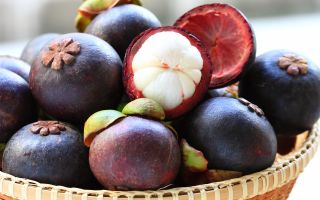Content
Mangosteen fruit is eaten, as a rule, much less often than usual apples and pears. The exotic fruit grows exclusively in the Malay Archipelago, due to which it is not widely distributed. It has a peculiar appearance and a very interesting taste. But the main feature is the composition of the mangosteen.
What mangosteen looks like
Mangosteen has a bizarre appearance. It is the fruit of an evergreen tree of the Kluziev family. Its diameter varies from 3 to 7 cm. A fairly thick rind has a rich purple color. The white pulp is shaped like a head of garlic. There are seeds inside each clove. The characteristic feature is a pleasant vanilla aroma. When broken, the pulp releases a large amount of juice.
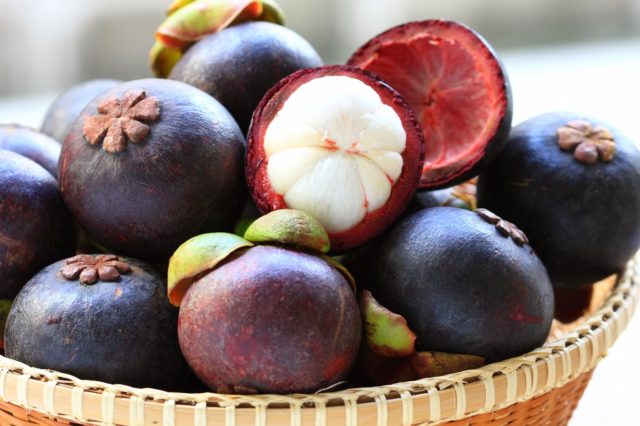
How and where does mangosteen grow
The islands of Indonesia are considered the birthplace of the mangosteen. Over time, the fruit began to be grown in Hawaii, Colombia, South America, India, Thailand and Puerto Rico. The height of the tree ranges from 6 to 26 m. It has spreading branches with oblong leaves. At first, they have a pale pink hue, and over time they turn green. Trees grow on special plantations. They do not require insect pollination.
What mangosteen tastes like
The fruit has a sweet taste with tart notes. The pulp literally melts when it enters the mouth. It is very juicy and delicious. Mangosteen has been compared to mango and pineapple. It is also believed that the fruit is similar to peaches and strawberries. But more often than not, exotic fruits are spoken of as the most unique, unlike anything else.
How to eat mangosteen
Peel the mangosteen before eating. The principle of cutting the fruit into pieces is the same as for citrus fruits. It is necessary to make neat cuts in the peel, and then divide the fruit into slices. You can also peel off the rind on one side and eat the pulp with a spoon. It is important to be careful as it is very juicy.
Most often, mangosteen is eaten raw, spitting out the bones. In exotic countries, desserts and various drinks are prepared from it. You can also preserve and dry the fruit to prolong its beneficial properties for a long time. Freezing mangosteen is undesirable. Under the influence of low temperatures, the fruit becomes watery and loses its taste.
How to choose the right mangosteen
When choosing a mangosteen, you should be guided by its appearance.The main parameter for determining the freshness of a fruit is the leaves located on the stalk. They should have a deep green color. The surface of the fruit is slightly springy when pressed. It has a dark purple color. The peel may be slightly damp and slippery to the touch.
How to ripen mangosteen at home
The ripeness of the fruit can be judged by the color saturation of the peel. If it is too light, then the fruit is not ripe. But it can be brought to the required state and at home. It is enough to hold it on the windowsill for a couple of days. It is advisable to store the ripe mangosteen in the refrigerator. In this case, it will be usable within two weeks.
How to peel mangosteen
The process of cleaning mangosteen is easy. The main thing is not to damage the fruit pulp when removing the peel, and immediately get rid of the stalk. It is advisable to clean it with a sharp knife. You can also make several cuts on the surface of the peel, and then divide the fruit into slices.
How to eat mangosteen right
Only white pulp is eaten. You can only remove the top of the peel and eat with a spoon. It is also acceptable to divide the fruit into slices by analogy with citrus. In cafes, the fruit is often served with a fork, since it is convenient for it to cling to pieces of mangosteen.
Is it possible to eat mangosteen bones
Mangosteen bones are not eaten. They are distinguished by pronounced bitterness. In some cases, they are used for treatment purposes. The bones of mangosteen contain substances that have a stimulating effect on the work of digestion. But the question of their use must be discussed with the attending physician.
How to store mangosteen at home
Mangosteen can be stored both in the refrigerator and at room temperature. In the first case, its shelf life will be longer. In the heat, it shrinks.
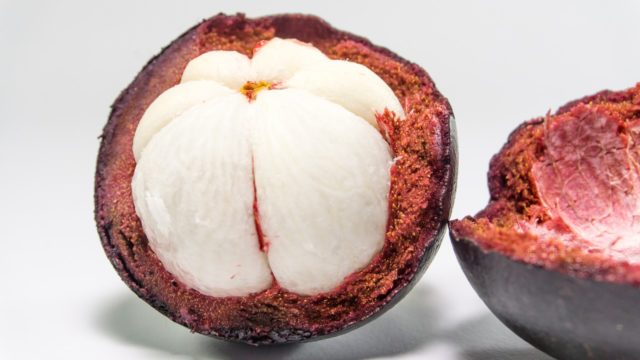
The value and composition of mangosteen
The exotic fruit is not only delicious, but also extremely healthy. It contains a record amount of xanthones, which have a range of medicinal properties. In addition, there are many vitamins and minerals in mangosteen. Because of this, it has a beneficial effect on the immune system. The fruit contains the following components:
- antioxidants;
- minerals (iron, potassium, magnesium, phosphorus, manganese, zinc, calcium);
- alimentary fiber;
- fatty acid;
- xanthones;
- catechin;
- vitamins of groups C, A, D, E and B;
- phytonutrients.
Vitamin content in mangosteen
The main advantage of mangosteen is its rich vitamin composition. Thanks to him, the fruit has a stimulating effect on the immune system. B vitamins equalize the emotional state of a person. For women, its benefit lies in the normalization of reproduction. The content of ascorbic acid ensures the activation of the body's defenses. Due to this, mangosteen reduces the risk of developing colds and viral diseases.
Calorie content of mangosteen
The presence of mangosteen in the diet does not contribute to excess weight gain. The calorie content of 100 g of the product is 62 kcal. BZHU is presented in the following ratio:
- proteins - 0.6 g;
- fats - 0.3 g;
- carbohydrates - 14 g.
Useful properties of mangosteen fruit
The fruit is introduced into the diet not only in order to diversify it, but also for medicinal purposes. The fact is that the composition of mangosteen allows you to strengthen the body's defenses and prevent a number of diseases.
The beneficial properties of exotic fruits include:
- protection against pathogenic microbes;
- anti-inflammatory action;
- anti-aging effect;
- acceleration of regenerative processes;
- help with insomnia and nervous exhaustion;
- elimination of symptoms of the premenstrual period;
- prevention of oncology;
- antioxidant effect;
- stabilization of blood pressure.
Useful properties of mangosteen peel
Despite the fact that the peel of the fruit is not eaten, it has many beneficial properties. Therefore, it is not recommended to throw it away. The peel can be dried and added to the preparation of tea and various infusions. It contains pectin, which has a stimulating effect on the digestive system.
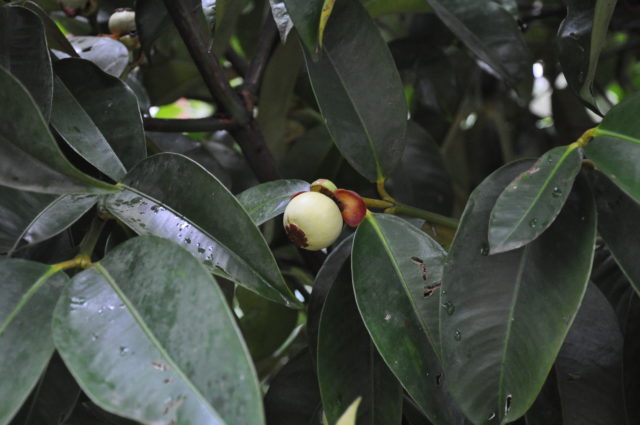
Other beneficial properties of the peel include:
- antiviral effect;
- restorative effect on the body;
- help with diarrhea and dysentery;
- antiparasitic effect.
Useful properties of bark and leaves
For medicinal purposes, the bark and leafy part of the plant are often used. Dried raw materials act as a basis for vitamin tea with a tonic effect. It normalizes blood pressure and helps to eliminate bad cholesterol from the body.
Why mangosteen is useful for the body
Since ancient times, mangosteen has been popular in the fight against serious diseases. In Asian countries, it was used to treat ailments of the musculoskeletal system, reproduction and digestive organs. Today it is one of the richest sources of vitamins and minerals.
The beneficial properties of the fruit are especially pronounced in the presence of the following diseases:
- obesity;
- hormonal disorders;
- pathology of the digestive system;
- cardiovascular diseases;
- viruses and colds;
- decreased reproductive function and ailments of the genitourinary system;
- skin diseases;
- brain disorders.
Application of mangosteen
Mangosteen is especially popular in cooking. Due to its taste, it is often used for making desserts. It is in no less demand in alternative medicine. This is due to the huge number of beneficial properties of the fruit.
For medical purposes
For medicinal purposes, not fresh fruits are most often used, but tinctures and decoctions based on seeds and peels. A healing drink helps to replenish the supply of vitamins and cope with a specific problem. It can be used as an adjunct to mainstream therapy.
In cosmetology
Mangosteen extract is often added to cosmetic products designed to protect and care for the skin of the face. It contains substances that create a barrier against pathogens. In addition, the fruit accelerates the regenerative processes, which helps with post-acne and age spots. Its antioxidant properties ensure the elimination of toxins from the epidermis. This makes the skin look fresher and healthier.
Masks based on mangosteen juice can also be made at home. In combination with other beneficial ingredients, the effect of the fruit is enhanced. Powder made from mangosteen peel has the ability to fight eczema and acne.
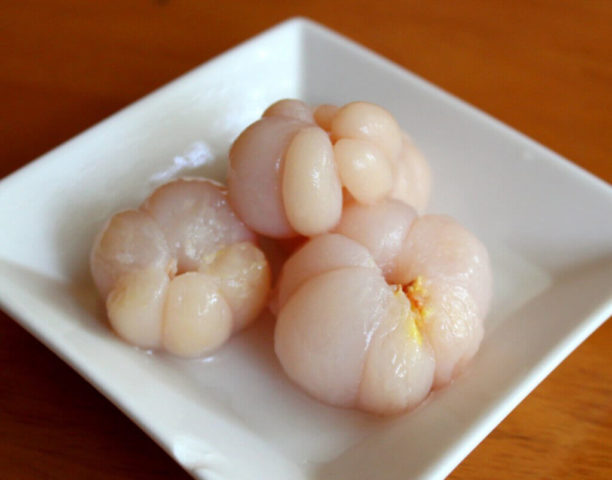
In dietetics
The beneficial properties of the fruit make it possible to successfully use it for weight loss. Due to its low calorie content, it does not have a negative effect on the figure. The enzymes present in its composition accelerate the metabolism, which helps to get rid of extra pounds. In dietetics, not only fresh fruits are popular, but also mangosteen-based dietary supplements. Before using them, it is advisable to consult a specialist.
In cooking
They try not to heat the mangosteen. It neutralizes some of the beneficial properties and changes the taste of the product. It is most commonly used in cocktails, desserts and fruit salads. Sometimes jams or preserves are made on the basis of mangosteen.
For other purposes
In the pharmaceutical field, mangosteen oil extracted from the peel of the fruit is very popular. It is used not only to eliminate cosmetic imperfections, but also to massage. Due to its antimicrobial effect, the fruit is often added to deodorants and natural antiseptics. The natural dye present in the peel is used to tan leather. This method is very popular in China.
Limitations and contraindications
In rare cases, eating mangosteen can provoke adverse reactions. To prevent this from happening, you need to familiarize yourself with the contraindications.
These include the following:
- increased acidity of the stomach;
- allergic reaction;
- disruption of the kidneys.
The effect of the fruit on the body of pregnant and lactating women is not fully understood. Therefore, it is advisable to refrain from using it. Allergy sufferers need to use mangosteen with extreme caution in small portions. When undesirable reactions appear, it is immediately removed from the diet. To avoid the consequences, only ripe fruit should be eaten.
While taking drugs that have a thinning effect on the blood, you should stop using mangosteen. It slows down the healing process and makes the person feel worse.
Conclusion
The mangosteen fruit is eaten most often to satisfy gourmet needs. It has a unique taste and an unusual appearance. Due to its exotic nature, the product should be introduced into the diet with extreme caution, taking into account all contraindications.

